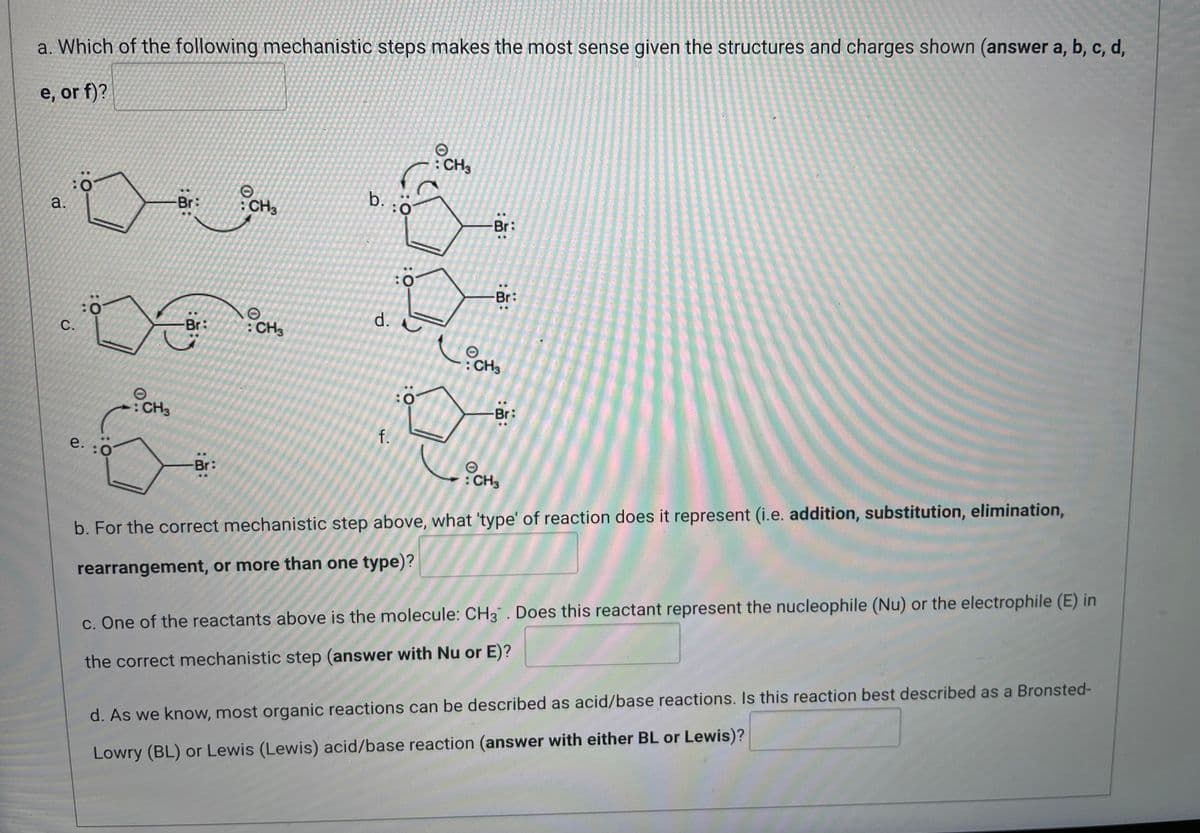a. Which of the following mechanistic steps makes the most sense given the structures and charges shown (answer a, b, c, d, e, or f)? : CH3 b. -Br : CH3 a. CH₂ -Br: -De C. -Br: ** CH3 f. e. :o CH₂ b. For the correct mechanistic step above, what 'type' of reaction does it represent (i.e. addition, substitution, elimination, rearrangement, or more than one type)? c. One of the reactants above is the molecule: CH3. Does this reactant represent the nucleophile (Nu) or the electrophile (E) in the correct mechanistic step (answer with Nu or E)? d. :0 :0 -Br Br: LOCH₂
a. Which of the following mechanistic steps makes the most sense given the structures and charges shown (answer a, b, c, d, e, or f)? : CH3 b. -Br : CH3 a. CH₂ -Br: -De C. -Br: ** CH3 f. e. :o CH₂ b. For the correct mechanistic step above, what 'type' of reaction does it represent (i.e. addition, substitution, elimination, rearrangement, or more than one type)? c. One of the reactants above is the molecule: CH3. Does this reactant represent the nucleophile (Nu) or the electrophile (E) in the correct mechanistic step (answer with Nu or E)? d. :0 :0 -Br Br: LOCH₂
Macroscale and Microscale Organic Experiments
7th Edition
ISBN:9781305577190
Author:Kenneth L. Williamson, Katherine M. Masters
Publisher:Kenneth L. Williamson, Katherine M. Masters
Chapter58: The Synthesis Of An Alkyne From An Alkene By Bromination And Dehydrobromination: Stilbene And Diphenylacetylene
Section: Chapter Questions
Problem 3Q
Related questions
Question

Transcribed Image Text:a. Which of the following mechanistic steps makes the most sense given the structures and charges shown (answer a, b, c, d,
e, or f)?
: CH3
:Ö
O
: CH3
b. :0
Br:
O
: CH3
f.
e. :0
Ⓒ
Br:
: CH3
b. For the correct mechanistic step above, what 'type' of reaction does it represent (i.e. addition, substitution, elimination,
rearrangement, or more than one type)?
c. One of the reactants above is the molecule: CH3. Does this reactant represent the nucleophile (Nu) or the electrophile (E) in
the correct mechanistic step (answer with Nu or E)?
d. As we know, most organic reactions can be described as acid/base reactions. Is this reaction best described as a Bronsted-
Lowry (BL) or Lewis (Lewis) acid/base reaction (answer with either BL or Lewis)?
a.
C.
:0
: CH3
Br:
d.
SO:
:0
Br:
-Bri
: CH3
Br:
Expert Solution
This question has been solved!
Explore an expertly crafted, step-by-step solution for a thorough understanding of key concepts.
This is a popular solution!
Trending now
This is a popular solution!
Step by step
Solved in 2 steps with 1 images

Knowledge Booster
Learn more about
Need a deep-dive on the concept behind this application? Look no further. Learn more about this topic, chemistry and related others by exploring similar questions and additional content below.Recommended textbooks for you

Macroscale and Microscale Organic Experiments
Chemistry
ISBN:
9781305577190
Author:
Kenneth L. Williamson, Katherine M. Masters
Publisher:
Brooks Cole

Organic Chemistry: A Guided Inquiry
Chemistry
ISBN:
9780618974122
Author:
Andrei Straumanis
Publisher:
Cengage Learning

Macroscale and Microscale Organic Experiments
Chemistry
ISBN:
9781305577190
Author:
Kenneth L. Williamson, Katherine M. Masters
Publisher:
Brooks Cole

Organic Chemistry: A Guided Inquiry
Chemistry
ISBN:
9780618974122
Author:
Andrei Straumanis
Publisher:
Cengage Learning